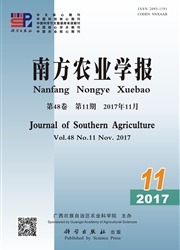

 中文摘要:
中文摘要:
【目的】明确近年来广西45个主要栽培水稻品种的抗性基因遗传多样性,揭示其遗传差异,为更好筛选水稻品种组合和通过品种间轮作及合理布局控制病害提供理论依据。【方法】根据已克隆的抗病基因设计5对RGA引物,对广西45个主栽水稻品种进行抗病基因同源序列分析并构建聚类图谱。【结果】在45个水稻品种的抗病基因中,共扩增出813条带,其中多态性条带124条,多态率达76.07%。聚类结果显示,不同品种间遗传相似系数变幅为0.61~0.93,取相似系数0.67时,可将45个水稻品种分为5大类,聚类结果在一定程度上反映品种来源的地域性和亲缘关系。【结论】广西不同主栽水稻品种间抗病基因数量差异较大,在广西稻瘟病发生严重的地区,采取不同抗性遗传背景的水稻品种轮作及混栽是控制该病害最为有效的措施之一。
 英文摘要:
英文摘要:
[Objective]The present experiment was conducted to assess the genetic diversity in relation to genetic variations in disease resistance amongst 45 main rice cultivars of Guangxi.[Method]Five pairs of RGA primers were designed on the basis of already identified disease resistant genes in order to find out the presence or absence in 45 rice cultivars.[Result]Total 813 bands were amplified from 45 rice cultivars,of which 124 were polymorphic and the polymorphic rate was 76.07%.The cluster analysis result showed that the similarity coefficient of these cultivars ranged from 0.61 to 0.93 and these cultivars were divided into 5 classifications at 0.67.It also revealed the presence of five distinct indicating regionalism and distant genetic relationships amongst rice cultivar sources.[Conclusion]Significant genetic variations have been observed in resistance to various diseases.Cultivar rotation and planting of mixed-cultivars with different genetic backgrounds have been suggested as an effective way for controlling rice blast disease in Guangxi.
 同期刊论文项目
同期刊论文项目
 同项目期刊论文
同项目期刊论文
 期刊信息
期刊信息
